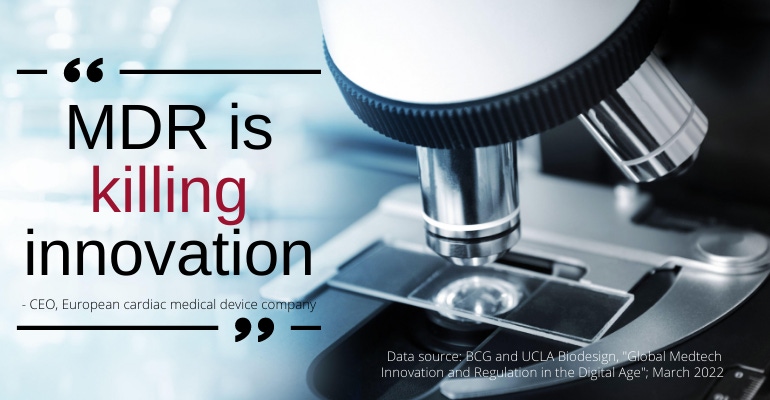Four startling conclusions from a Medtech Europe survey on how the new Medical Device Regulation (MDR) is impacting innovation in the EU.
July 21, 2022

For decades it was a widely accepted strategy to bring new medical devices to the European market first. Simply put, obtaining a CE mark was faster, cheaper, and more predictable than getting regulatory approval anywhere else. Those days are gone, however, and many medical device professionals are blaming the new Medical Device Regulation (MDR) in Europe.
A survey of MedTech Europe members conducted during the month of April has yielded four startling conclusions about the implementation of the Medical Device Regulation in the European Union. The survey was commissioned by the Medical Device Coordination Group Task Force on Certification Capacity Monitoring to assess the availability of medical devices in 2022 in connection to the MDR implementation. The responses by the companies that participated in the survey lead to the following conclusions:
MDR certificates have not been issued yet for more than 85% of the more than 500,000 devices previously certified for market in the European Union.
54% of survey respondents said they do not intend to transition some of their portfolio to the MDR. All product categories are impacted by potential device discontinuations, MedTech Europe noted.
Small and medium medical device companies face more challenges in MDR implementation than larger companies. At least 15% and up to 30% of small and medium companies still have no access to an MDR-designated notified body. For small and medium medical device companies, progress to MDR certification is slower than average, the survey showed.
MDR is currently a disincentive against launching medical device innovation in the European Union, MedTech Europe noted. About 50% of respondents are de-prioritizing the EU market (or will do so) as the geography of choice for first regulatory approval of their new devices.
The full report can be found here.
MDR ended the days of Europe-first medical device innovation
These conclusions are not at all unlike the report published earlier this year by the Boston Consulting Group (BCG) and UCLA Biodesign, which also shows that the new regulation has slowed the pace of medical device innovation in the European Union. In other words, gone are the days of Europe-first medical device innovation.
That report was based on a survey of 104 company leaders who provided commentary and data on 105 new medical devices, technologies, and software of any risk class that have achieved 510(k) clearance or FDA approval, or have attained a FDA breakthrough device designation. Many of the products also sought EU CE mark, Japan PMDA (Pharmaceuticals and Medical Devices Agency), or China NMPA (National Medical Products Association) approval in the period from 2010 to 2021. Most (85%) of the technologies represented are new products in their respective portfolios rather than line extensions or updates, the authors note, and 60% of them incorporate digital technology.
Nearly half of the products in the survey had been launched in EU markets, but 89% of companies sponsoring these products said they will prioritize U.S. regulatory nods going forward. In fact, 23% of respondents with successful CE mark products said they will pursue Japanese and Chinese registration prior to EU clearance.
About the Author(s)
You May Also Like




